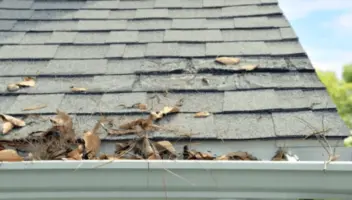Cleaning out gutters is a dirty but essential part of any home maintenance routine. Gutters protect your home from water damage by diverting water away from your house.
If your gutters are clogged, they won’t work properly, which can lead to serious damage to your home.
Learning how to clean gutters from the ground without using a ladder not only keeps you safe, but it also ensures your gutters are properly functioning.
The safest way to clean out your gutters is to clean them from the ground, without using a ladder. Read on to discover how to safely clean out your gutters from the ground using proven methods and helpful gutter cleaning tools.
In This Article:
- Why It’s Important to Clean Out Gutters
- Best Methods to Clean Gutters from the Ground
- How to Stop Gutters from Clogging
- Frequently Asked Questions
Why It’s Important to Clean Out Your Gutters

Photo by Connor Martin from Pexels
Gutters play a vital role in protecting your home from water damage. If you have clogged gutters, water can leak into your windows or the basement of your home. This sitting water can quickly cause damage to the roof, siding, and foundation.
When allowed to build up over time, leaves decay, other debris becomes wet and begins to rot, and mold develops. This wet, rotting environment is especially attractive to various types of pests like wasps, roaches, ants, and rodents. Plus, gutters that aren’t draining properly may fill with standing water, creating an ideal breeding ground for mosquitoes.
In the winter, melting snow and freezing rain can cause ice dams to form in clogged gutters. Ice dams can pull your gutters away from the roof, and even pose a danger to people walking below. That’s why we recommend that homeowners should clean out their gutters at least twice a year.
To avoid these types of issues, gutter guards are the ideal solution. They block debris, preventing clogs from occurring inside your home’s gutters, and—depending on the type of gutter guards—require minimal maintenance to work properly.
The 5 Best Methods to Clean Out Your Gutters from the Ground
It will take longer to clean gutters out from the ground than using a ladder since it can be difficult to directly see the top or inside of the gutter system. But overall, it’s easier and safer.
Here are the best methods to clean out your gutters from the ground, so you don’t have to use a ladder and take unnecessary risks. Don’t forget to always wear protective gear when cleaning your gutters to avoid injury.
1. Leaf Blower Method

Photo by Chaiyawat Sri-Napom from Shutterstock
Using a leaf blower is an effective way to clean out your gutters from the ground. You can purchase an attachment for your leaf blower, which allows you to clean out your gutters without climbing up a ladder.
Pros: Using a leaf blower is best for heavily clogged gutters filled with debris such as packed leaves, dirt, and twigs. Make sure you have a rake handy to clean up your lawn afterward.
Cons: A leaf blower can damage your gutters if too much force is applied, and they’re not always as effective at removing wet or compacted debris.
2. Wet/Dry Vacuum Method

Photo by Charles Mann from Shutterstock
A wet/dry vacuum or shop vac extension allows you to vacuum your rain gutters from the ground. Many online retailers and hardware stores carry these kits for purchase or rent.
Pros: The powerful suction allows you to remove debris and standing water quickly by acting as a gutter vacuum. In some cases, the long hose allows you to reach second-story roofs from the ground.
Cons: Wet/dry vacuums can be heavy and unwieldy to maneuver. Heavier debris like twigs or wet leaves may clog the vacuum hose and attachment.
3. Garden Hose Method

Photo by Mike Bird from Pexels
A standard garden hose is another great option for cleaning out your gutters from the ground. Garden hose attachments–with a curved end–are widely available at your local home improvement store.
Pros: Garden hoses are convenient and readily available for most homeowners, and the water pressure acts as a gutter flusher to remove debris effectively.
Cons: They’re not as effective on tightly packed debris that resists flushing. Hoses also don’t fully remove all debris, and the excessive water can leak into fascia and soffits, which can cause rot.
4. Pressure Washer Method

Photo by Virrage Images from Shutterstock
For heavy-duty gutter cleaning, turn to a power or pressure washer. A gutter cleaning attachment allows you to blast away caked-on dirt and debris.
Pros: This method is perfect for gutters that haven’t been cleaned in a long time. It quickly and efficiently removes packed dirt and leaves and clears clogged downspouts.
Cons: Using a pressure washer can get messy, so wear work clothes and plan to hose down your siding afterward.
5. Boiling Water Method
Using boiling water with a high temperature-rated pressure washer is one way to effectively clean an ice-dammed or clogged gutter from the ground. Only do this if your pressure washer is made for hot water though or you may ruin your unit.
Pros: The hot water can remove tough clogs or ice before they damage the gutter system.
Cons: Using boiling water from a distance can result in splashback and potential injury if not done carefully.
When to Hire a Professional

When it comes to cleaning out your gutters from ground level, it’s always better, more efficient, and safer to hire a professional gutter cleaning service. A professional gutter cleaner has the proper equipment and training to access hard-to-reach gutter systems safely. Expect to pay around $162 on average for this service.
Also, never climb on your roof to clean out your gutters. It’s not worth the risk or hassle.
If you have an asphalt shingle roof, the tread on your shoes can loosen shingle grit, weakening your shingles. Professional gutter cleaning companies wear specially designed roofing shoes that won’t cause damage if they need to step or stand on your roof to clean out your gutters.
How to Stop Gutters from Clogging

Photo by Ground Picture from Shutterstock
The best way to avoid having to clean out gutters with or without a ladder is to prevent them from clogging in the first place. Regular gutter maintenance can go a long way in keeping debris from clogging inside your gutters and reducing the frequency of gutter cleaning.
However, installing the right gutter guards is a long-term solution that keeps your gutters clog-free and ensures you won’t need to clean out your gutters multiple times a year.
LeafFilter gutter guards keep leaves and debris out while allowing water to freely run through. Our patented stainless steel micro-mesh screen has no holes, gaps, or large openings, so even pine needles, shingle grit, seed pods, and pollen stay out.
Our award-winning gutter protection system installs directly onto your gutters without disturbing your roof and helps prevent the damage that can result from clogged gutters.
Plus, unlike some other types of gutter guards, you don’t need to remove LeafFilter gutter guards to clean out your gutters and clean underneath the guards. That’s because our clog-free guarantee means you don’t need to worry about cleaning out your gutters again.
Ready to learn more about how LeafFilter can make climbing a ladder to clean out your gutters a thing of the past? Click here or call us toll-free today at 1-800-290-6106 for a free estimate.
Frequently Asked Questions

Photo by Budimir Jevtic from Shutterstock
Can you clean out gutters from the ground, without using a ladder?
Yes, you can clean out first story gutters from the ground using tools like gutter cleaning wands, extended poles, and special attachments for leaf blowers or wet/dry vacuums.
How do you clean out gutters that can’t be reached?
To clean out gutters that can’t be easily reached from the ground, try an extended pole system. By connecting poles, you can create a pole long enough to attach a gutter scoop or brush to clean from the ground. Poles are available in a range of different modular sizes.
Is there a way to clean out second story gutters from the ground?
Use an extension pole that can attach gutter cleaning tools, allowing you to reach second story gutters safely from the ground. Pole lengths can extend up to 40 feet maximum.
Why is there so much dirt inside my gutters?
Debris builds up over time but can be exacerbated by nearby trees. Additionally, improperly pitched gutters can hold sediment and roof runoff from materials like asphalt shingles.
What are the best tools to clean out gutters without a ladder?
The best tools are gutter cleaning wands, extended poles that attach to gutter scoops or brushes, high pressure sprayer wands, and wet/dry vac attachments made specifically for gutter cleaning from the ground.
How do I know if my gutters need to be replaced?
There are several ways to know if your gutters need to be replaced. For instance, if you notice sagging, leaking, cracks, or breaks, those are signs your system is due for replacement. Water pooling in the gutters is another indicator that you need new ones.
How often should I clean gutters?
Ideally, you want to clean your gutters at least twice a year. Often homeowners do this during mid-spring and mid-fall to remove seasonal debris like fallen leaves, twigs, and pine needles.
Who can I hire in my area to clean out clogged gutters?
If your gutters need cleaning, check out one of these nearby locations:
- Gutter cleaning in Richmond, Virginia
- Gutter cleaning in Columbus, Ohio
- Gutter cleaning in Raleigh, North Carolina
- Gutter cleaning in Cincinnati, Ohio
- Gutter cleaning in Louisville, Kentucky
- Gutter cleaning in Atlanta, Georgia
- Gutter cleaning in Greenville, South Carolina
- Gutter cleaning in Nashville, Tennessee
You can also click to see all of our locations!

